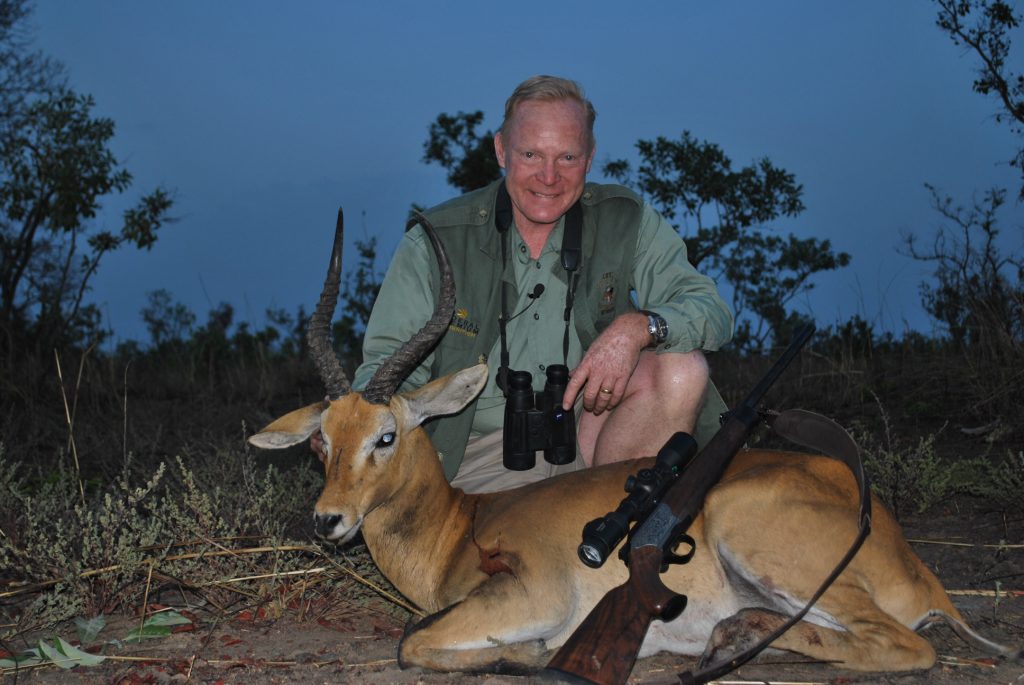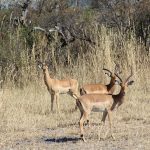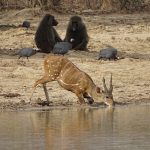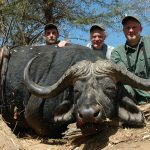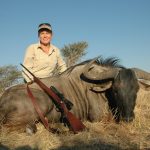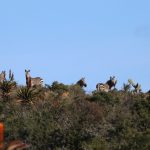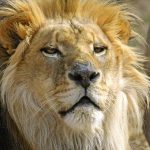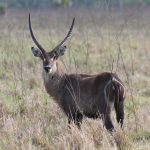Depending on where you go in Africa, it might be an impala, springbok, reedbuck, gazelle, or kob.
Thanks to Chevrolet, the impala is probably the best known and most recognizable African antelope. An attractive reddish-gold in color, highly acrobatic, and topped with black, heavily ringed, lyre-shaped horns, the impala occupies a broad range across most of Southern Africa, and on up through East Africa into Uganda. The impala is a gregarious, highly prolific creature of thornbush and open forest.
Across most of his range he is usually the most common medium-size antelope. Few hunters will put the impala on top of their wish list, but most will hunt him, and well they should. As camp meat, impala is as good as it gets. Fresh impala liver is mild and delicious, a real treat! As the most available antelope, often with the most liberal quota, impala is a preferred leopard bait for many PHs. A shoulder-mounted impala is a classic piece of Africana and, unlike many African antelopes, will be readily recognized.
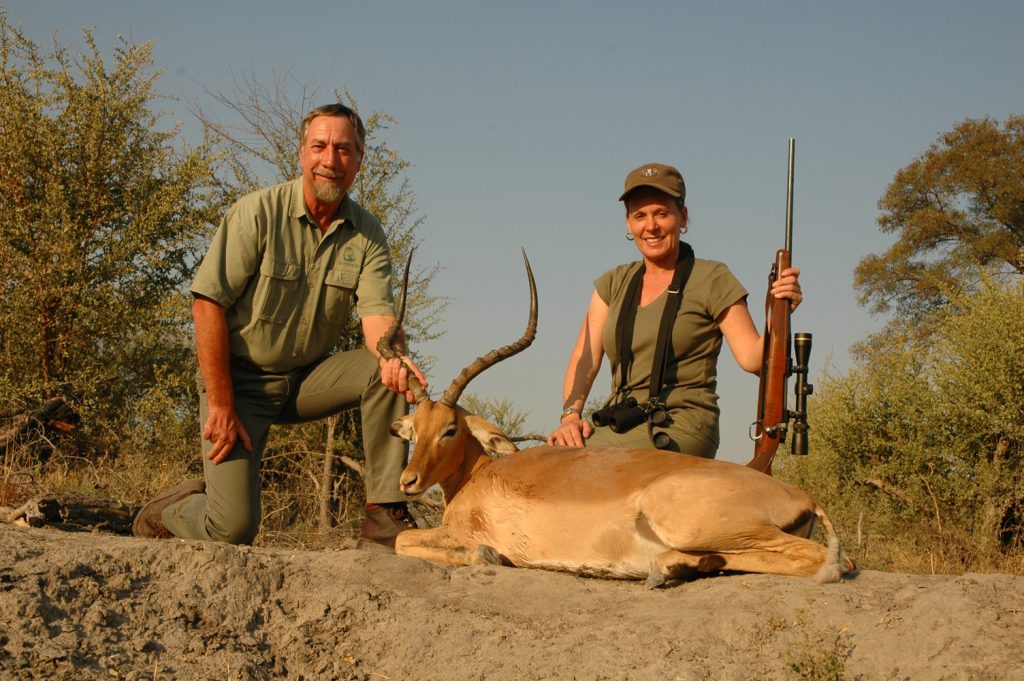
As I’ve often said, common game isn’t always so common. Impala are usually plentiful and highly visible. However, all predators love impala, so they are extremely nervous, constantly alert, and usually difficult to approach. And, like exceptional specimens of most plentiful animals, really good impalas are few and far between.
A big ram may be found as the patriarch of a large harem, making the approach difficult because you must stalk past sharp-eyed ewes. Older rams are also found in bachelor groups, often of like age, so now you must sort him out through a shifting forest of similar horns. Most of the time it takes multiple stalks to get a shot.
The legend that African game is somehow “tougher” than other game is mostly malarkey. However, pound for pound, the little impala, maximum 150 pounds, is one of the tough ones. Perhaps it’s because they are always keyed up, but an impala must be hit properly, or else you’re in for a long tracking job. It was on one of those long tracks on a hot day in the Zambezi Valley, following an impala hit just a bit far back, that Tim Danklef commented, “It’s a good thing impala aren’t as big as buffalo, otherwise we’d all be dead!” African professional hunters consistently exhort their clients to forget the behind-the-shoulder lung shot and go for the shoulder. Regardless of what you’re shooting, an impala ram needs to be shot on the center of the shoulder, unless you like tracking with uncertain conclusion.
If a good impala ram is desired (and one should be), then most hunters will be successful. Length of horn is all you have to go on, but shape is important. Ideally, you want the bottom half of the horns to flare out, then end with long tips that are more or less straight up and parallel. Not all impalas achieve this shape, but a ram with tips that curve inward usually has some growing to do.
We identify three races of impala. Most widespread and plentiful is the southern impala. The East African impala is larger in body with much longer horns. Most limited is the Angolan or black-faced impala, found from Etosha Park north into Angola. A bit smaller in both body and horn, the black-faced impala is distinguished by a prominent black stripe down the nose. Regrettably, this impala in not importable into the U.S., a fact that greatly hampers management.
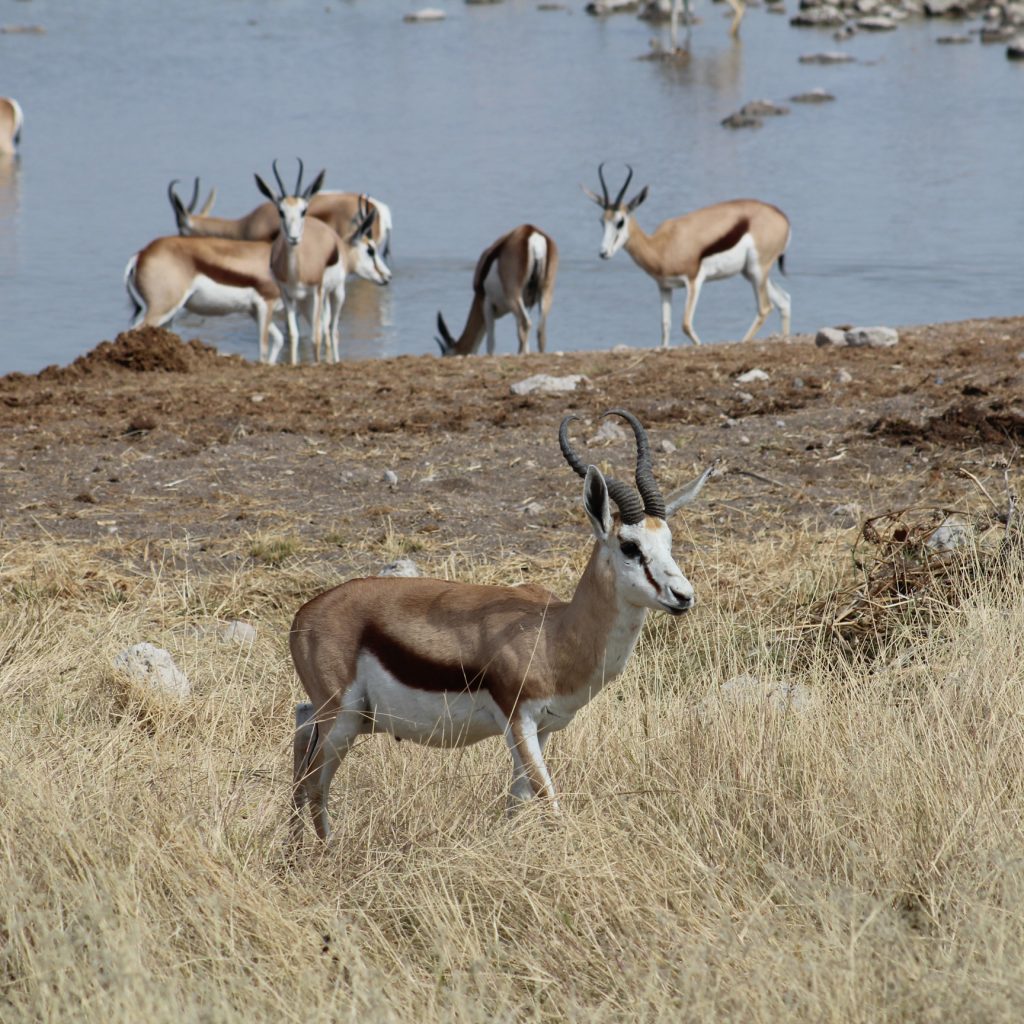
Impalas are generally not found in deserts, nor in marshy habitat. In the deserts of southern Africa, the springbok takes over as the most common medium-size antelope. The national animal of South Africa, the springbok is technically a pseudo-gazelle, while in arid country in East and North Africa his place is taken by one of the several true gazelles, ranging in size from very small, like Thomson and Dorcas gazelles, to the various races of Grant gazelle, which are similar to the impala in size. All these desert antelopes are hunted much like we hunt our pronghorns; they are sharp-eyed open-country animals that are difficult to stalk. They’re also small targets that require longer and more precise shooting than many African antelopes.
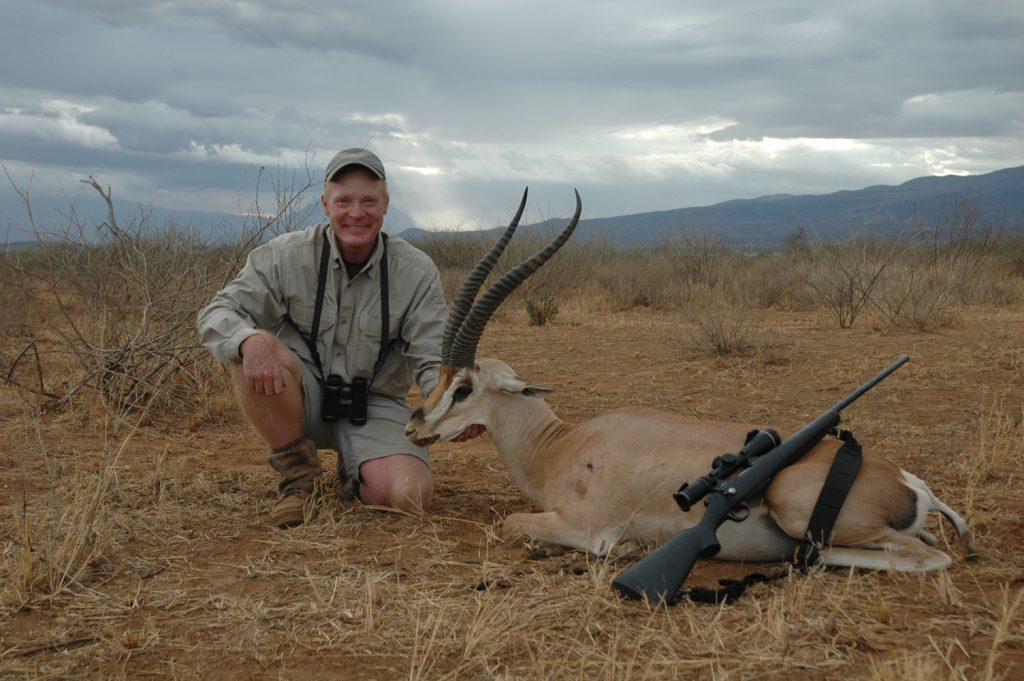
In grasslands, and on floodplains near marshy areas, the reedbucks often take over as the most common antelopes. From Natal up through coastal Mozambique, the common reedbuck is far and away the most plentiful medium-size antelope. In the big Coutadas near the mouth of the Zambezi impalas occur, but they are uncommon, while hundreds of reedbucks might be seen daily. The common reedbuck varies from tan to gray. A blocky, robust antelope, he is heavier in the body than the impala, with straight, ringed horns that curve outward and tilt usually tilt forward into sharp tips. All the reedbucks have soft, pulpy bases, incipient horn growth that is difficult to preserve. The common reedbuck is widespread in northeastern South Africa, and extends northward into Tanzania. By the way, reedbuck are even tastier than impala.
There is just one common reedbuck, but there are two other species, the mountain reedbuck and bohor reedbuck, both with multiple races. Bohor reedbuck are much smaller, a typically a brighter, yellowish tan, with short, thick horns, rarely with much spread and a radical forward curve. We divide them into regional groupings, to me visually indistinguishable. The East African bohor reedbuck starts in Tanzania and is common in Uganda. The Sudan bohor reedbuck is found to the northwest; the Abyssinian bohor reedbuck in Ethiopia. Farther west lies the Nigerian bohor reedbuck; and in West Africa the Nagor reedbuck. Typically, the bohor reedbucks are found in pairs and small groups in grasslands, often near riverine cover or marshy habitats.
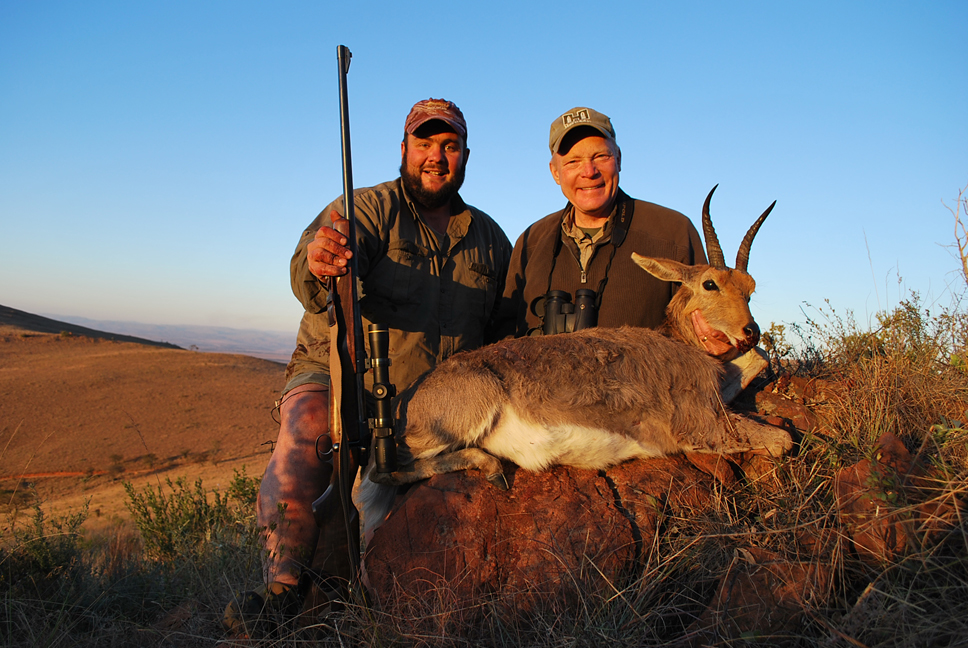
Smaller still and gray in color are the mountain reedbucks, typically found on grassy slopes at higher elevations. Most numerous and widespread is the southern mountain reedbuck, found in most of South Africa’s ranges. Even smaller, the Chanler mountain reedbuck is found on some mountains in Masailand, on north through Kenya into Ethiopia, and on west into Uganda. Smallest and rarest is the western mountain reedbuck, known to occur in just a couple of spots in northern Cameroon. Long protected, I actually saw one while hunting eland in the Mayo N’Duell block. It was unmistakable small and gray, definitely not a bohor reedbuck.
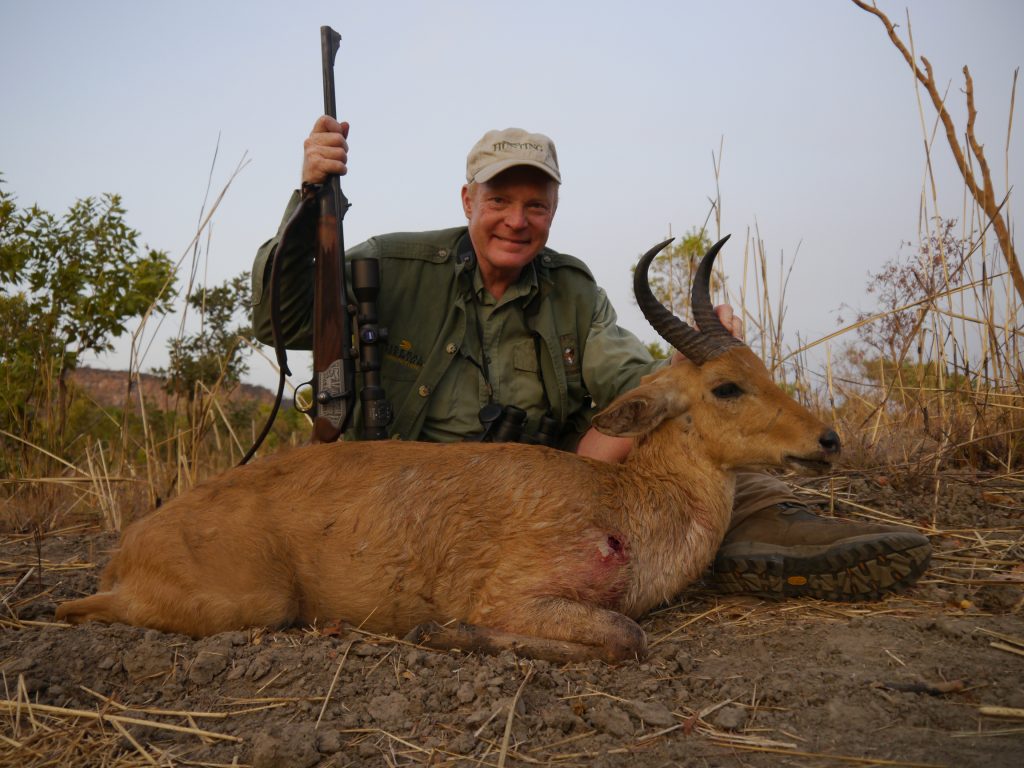
When disturbed, the reedbucks give a shrill and distinctive alarm call, which is one way of locating them. Unless badly spooked, all the reedbucks are likely to run a short distance and then go to ground in the long grass they love. Mark the spot well! That’s an opportunity for a stalk, but it’s likely to result in a running shot when the animal jumps up at your feet.
In western Uganda we run out of the impala’s range, but there’s a lot of great hunting country to the west, north of the forest and south of the Sahara, all the way across the huge bulge of West Africa. In proper habitat there are bohor reedbuck throughout, but across this huge region the kobs usually take over as the most plentiful and widespread medium-sized antelope, and become the “common game.”
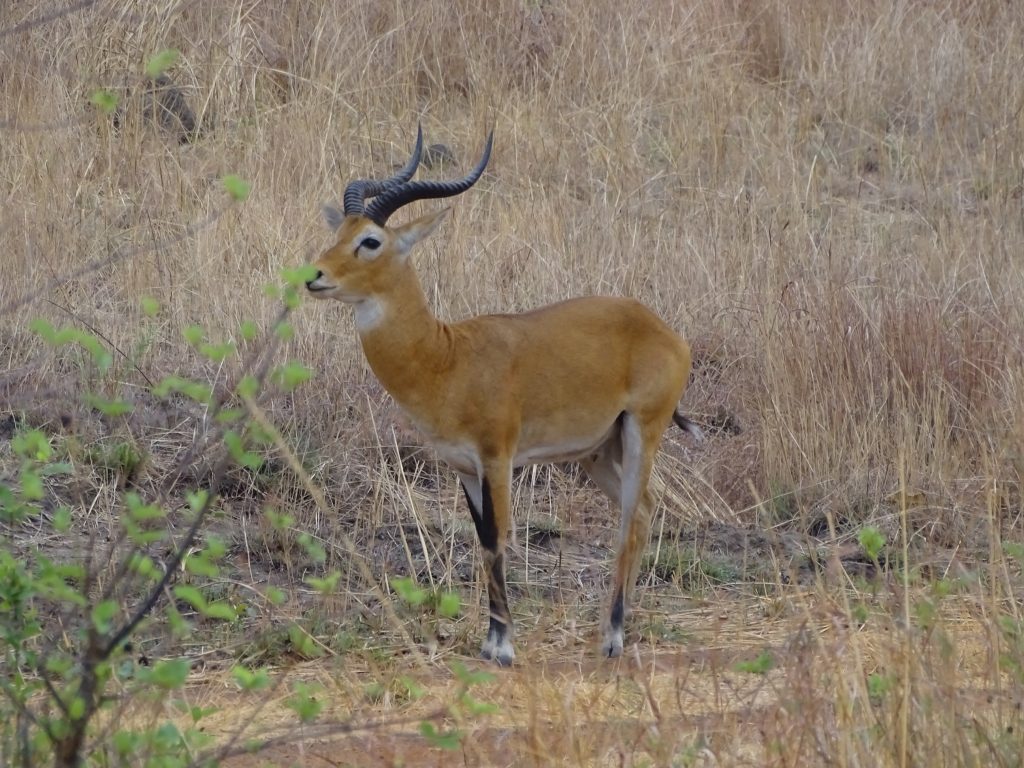
The waterbucks, kobs, lechwes, and reedbucks are related, and are all associated with well-watered areas with lots of grass. The puku, also known as Vardon’s kob, is discontinuous from Angola across Zambia and into southwestern Tanzania. The white-eared kob, though common in South Sudan’s East Equatoria, hasn’t been hunted since the early 1980s. Just this year, a white-eared kob was seen in Uganda’s Karamoja, not far from the Sudan, the first known sighting in decades. Uganda’s national animal, the Uganda kob, is plentiful in northwestern Uganda, and probably is the most common antelope. The smaller western kob is found north of the forest in C.A.R. and Cameroon, and extends westward across the Sahel to Guinea.
The Uganda kob and white-eared kob are about the same size, up to 200 pounds, with thick, ringed, lyre-shaped horns up to about 24 inches. Mature white-eared kob have distinctive white ears, white facial markings and white underparts, and are the darkest, with some males almost black. The Uganda kob has more muted white markings with reddish body color. The western kob is smaller, up to 150 pounds, with smaller horns and a lighter, more golden body color. Farther west, both body and horn size declines, and to my eye body color keeps getting lighter. Because they are smaller, some references separate the kob from Nigeria westward as West African kob. In the few hunting areas in the Sahel—northern C.A.R., northern Cameroon, northern Benin, and eastern Burkina Faso—the kob is definitely the most plentiful antelope. It is a handsome animal, and, like all of our “most common” antelopes, it is very tasty.
